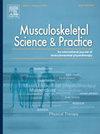在有肩关节肌肉骨骼症状的人群中,中枢敏感性的增加与肩关节残疾的加重有关:一项横断面研究
IF 2.2
3区 医学
Q1 REHABILITATION
引用次数: 0
摘要
背景:为了充分理解肩部疼痛和残疾,需要更好地了解可能导致慢性的因素,即增加中枢敏感性。目的在考虑混杂因素的情况下,确定中枢敏感性增高与肩部残疾之间的关系。目的:确定肩部肌肉骨骼症状患者中枢性敏感性增高的发生率。通过在线调查收集数据的横断面设计。有肩部症状的参与者是通过澳大利亚的社交媒体和传单广告招募的。方法采用中枢敏感量表和肩痛失能指数。混杂因素包括性别、年龄、社会经济地位、肥胖、心理困扰、睡眠质量、身体活动、吸烟、种族和神经性疼痛症状。在调整混杂因素的同时,通过线性回归评估中枢敏感性增加与肩部残疾之间的关系。计算中心敏感性增加的参与者的百分比。结果在249名有肩部症状的参与者中,无论是作为分类变量(系数5.5,95% CI 0.1-11.0, p 0.046)还是作为连续变量(系数0.2,95% CI 0.03-0.50, p 0.025),在调整混杂因素时,中心敏感性的增加与肩部残疾的加重呈正相关。在样本中,48.2%的调查对象达到了中心敏感性增加的阈值。结论:即使考虑到肩部肌肉骨骼症状的参与者的多重混杂因素,中枢敏感性的增加也与更大的残疾呈正相关。这些发现强调了在肩部症状患者的临床管理中考虑增加中枢敏感性的重要性。本文章由计算机程序翻译,如有差异,请以英文原文为准。
Increased central sensitivity is associated with greater shoulder disability in people with musculoskeletal shoulder symptoms: a cross-sectional study
Background
To fully comprehend shoulder pain and disability, a better understanding of the factors that may contribute to chronicity is required, i.e., increased central sensitivity.
Objective
To determine the association between increased central sensitivity and shoulder disability whilst accounting for confounding factors. To determine the prevalence of increased central sensitivity in those with musculoskeletal shoulder symptoms.
Design
Cross sectional design collecting data via an online survey. Participants with shoulder symptoms were recruited via social media and through flyer advertisement in Australia.
Methods
The Central Sensitivity Inventory and Shoulder Pain and Disability Index were used. Confounding factors included sex, age, socioeconomic status, obesity, psychological distress, sleep quality, physical activity, smoking, ethnicity, and the symptoms of neuropathic pain. The association between increased central sensitivity and shoulder disability was assessed by linear regression whilst adjusting for confounding factors. The percentage of participants with increased central sensitivity was calculated.
Results
In 249 participants with shoulder symptoms, increased central sensitivity was positively associated with greater shoulder disability, either as a categorical (coefficient 5.5, 95 % CI 0.1–11.0, p 0.046) or continuous variable (coefficient 0.2, 95 % CI 0.03–0.50, p 0.025) whilst adjusting for confounding factors. In the sample, 48.2 % of survey respondents met the threshold for having increased central sensitivity.
Conclusion
Increased central sensitivity was positively associated with greater disability even when accounting for multiple confounders in participants with musculoskeletal shoulder symptoms. These findings highlight the importance of considering increased central sensitivity in the clinical management of those with shoulder symptoms.
求助全文
通过发布文献求助,成功后即可免费获取论文全文。
去求助
来源期刊

Musculoskeletal Science and Practice
Health Professions-Physical Therapy, Sports Therapy and Rehabilitation
CiteScore
4.10
自引率
8.70%
发文量
152
审稿时长
48 days
期刊介绍:
Musculoskeletal Science & Practice, international journal of musculoskeletal physiotherapy, is a peer-reviewed international journal (previously Manual Therapy), publishing high quality original research, review and Masterclass articles that contribute to improving the clinical understanding of appropriate care processes for musculoskeletal disorders. The journal publishes articles that influence or add to the body of evidence on diagnostic and therapeutic processes, patient centered care, guidelines for musculoskeletal therapeutics and theoretical models that support developments in assessment, diagnosis, clinical reasoning and interventions.
 求助内容:
求助内容: 应助结果提醒方式:
应助结果提醒方式:


